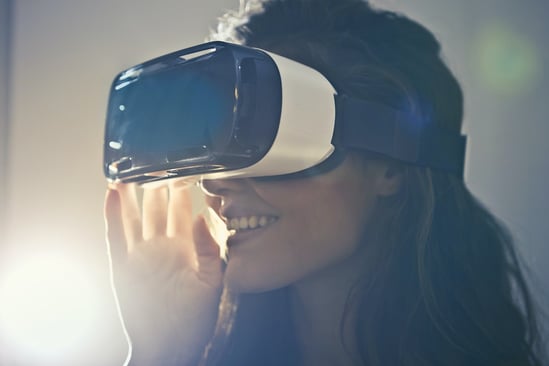Augmented Reality in Retail: How (and Why) It Works

Convenience plays a huge part in shopping today. Consumers want a quick and easy way to try on clothes, visualize how furniture will look in their apartments, and generally “try before they buy.”
Thanks to advanced technology, these types of offerings are becoming increasingly popular — and increasingly common — across multiple verticals in the retail space.
Augmented reality (AR) allows brands and retailers to introduce a variety of new and engaging shopping experiences, such as virtual fitting rooms, digital “try-ons,” and color matching for everything from paint to lipstick to hair dye.
Implementing AR in retail and ecommerce spaces creates an environment in which customers no longer need to physically try on clothes or makeup. It also takes the guessing game out of what furniture will look like in a shopper’s home, or what color wallpaper will go best with their green velvet sofa.
Ultimately, this reduces the number of returns, increases customer engagement, and leads to long-term loyalty.
What Is Augmented Reality (AR)?
Augmented reality is a blend of the digital and physical worlds. It’s a technology that enables users to layer digital components onto the real world around them.
Some video games, for example, use AR to create digital characters that interact with the physical world. Players can use their smart devices to see and hear the characters as they walk across the ground in front of them or engage with nearby objects.
If you’ve ever seen sports commentators draw digital lines on a football or soccer field to explain a play, you’ve witnessed AR firsthand.
But AR isn’t just for gaming and entertainment. It’s steadily becoming an essential part of most industries — including retail — giving brands a new, engaging way to connect with customers.
What’s the Difference Between Augmented Reality (AR) and Virtual Reality (VR)?
The biggest difference between virtual reality and augmented reality is that VR creates an entire world for users to immerse themselves in, while AR “augments” the real world through a screen.
Consumers need a headset to access virtual reality scenes, but augmented reality is used to show additional computer-generated objects, items, and information laid on top of real-world scenes.
In the retail world, AR can be used on:
- Smartphones and tablets;
- Wearables;
- Desktop devices;
- TVs;
- Digital mirrors; and
- Connected devices, like glasses, headsets, and lenses.
The possibilities are almost endless for providing a semi-immersive experience for shoppers with AR in retail.
What Is AR Used for in Retail?
According to G2 research, 61% of consumers prefer retailers that offer AR experiences, which is likely why retail accounted for 5% of the world’s AR usage in 2022 and why that number continues to grow each year. In fact, Snapchat predicts that nearly 75% of the global population will frequently use AR for shopping by 2025.
Retail AR is growing particularly fast in Europe. Statista data shows that the market size is set to grow from $2.8 billion in 2021 to $20.9 billion in 2025, with Germany placing a particular emphasis on using the technology.
Brands across the world are using AR in retail to create targeted marketing campaigns, customer engagement initiatives, and personalized shopping experiences.
Some eyewear brands, for example, use AR to overlay glasses onto a person’s face. Car brands use it to allow shoppers to see what customizations would look like on their new rides. By enabling shoppers to superimpose products into their space or onto their bodies, retailers are enhancing the customer experience — and driving sales in the process.
What Are Some Benefits of AR in Retail?
AR not only creates an innovative new way for consumers to shop, but it also provides plenty of benefits to the retailers and brands who are implementing it.
Reduce the Number of Returns
Allowing customers to virtually try on clothes and products before they buy them dramatically reduces the number of returns.
Increase Customer Engagement
Customers can play around with makeup colors, try on eyeglasses, and “put on” clothes without too much effort, increasing engagement with brands and their products.
Build Customer Loyalty
Giving customers what they want and ensuring their shopping experience is seamless will ultimately lead to long-term loyalty.
Collect Customer Data
Brands and retailers can use information from their AR activities to understand more about their customers, like their clothing sizes, product preferences, and buying habits.
Increase Sales
Customers are more likely to purchase products that they can “try out” hassle-free.
7 Engaging Ways Brands and Retailers Are Using Augmented Reality in Retail
1. Color Matching
It’s difficult for a customer to tell what a specific color of paint or lipstick will look like on their wall or against their skin tone — even when the item is right in front of them in person. It’s even more difficult to tell the color of a product through a screen.
AR can help customers match paint colors and makeup palettes by laying the paint or lipstick over a photo. The Dulux Visualizer app does exactly this — making it easier than ever for shoppers to choose the right wall color for their homes.
Image Source: Dulux Visualizer App
2. Virtual Fitting Rooms
Clothing is a category that presents a unique set of challenges for online shoppers. It can be difficult for a consumer to look at a product photo and visualize how the clothing item will look in real life on their own unique body.
Brands and retailers such as ASOS, Gucci, and Knix have experimented with virtual fitting rooms as a means of helping shoppers find the right size and style — without having to visit a physical store.
3. Interactive In-Store Displays
Once customers enter a store, it’s important to keep them engaged enough to purchase. Installing in-store displays with AR features can help shoppers browse your product catalog, personalize items, and find products that are a match for their style or skin tone.
4. Virtual Try-Ons
Shoppers are often hesitant to buy a product if they’re not sure it will look good on them. Brands and retailers are using AR technology similarly to virtual fitting rooms to let shoppers try on accessories and other items, like eyeglasses and hats.
Warby Parker has an AR app that lets shoppers upload a selfie to see how different types of eyeglasses look on them. The app works in tandem with the mobile site so customers can instantly add products they like to their cart.
5. Space Visualization
It’s difficult to picture what a sofa will look like in a room without it being in the room. AR in retail can help customers visualize how large furniture items will fit into their homes or offices — without having to commit to a purchase first.
Ikea’s AR app lets shoppers scan their room and place computer-generated, to-scale photos of their chosen products in the space.
Image Source: Ikea
6. Encourage Brand Engagement
Engagement is crucial for securing sales and retaining customers. Keeping shoppers entertained while they explore your products — and giving them a way to interact with your brand — can ensure they come back time and time again.
As Tech at Meta reports, Starbucks has used AR in the past to engage its customers by allowing them to scan their cups with their smartphones to create an animated scene.
7. Provide Additional Content
Customer relationships extend beyond the initial purchase. Securing long-term loyalty requires providing relevant content to shoppers to continue reminding them why they bought your product — and why they should buy from you again.
For example, food brand Francesco Rinaldi implemented an AR app that provides recipes and additional information about the brand’s sauces when a customer points their phone at the face of Mrs. Rinaldi.
Video Source: Twisted Rope
5 Retail Verticals That Really Benefit From AR
Multiple types of brands and retailers are using AR to enhance the customer experience. Most shoppers use AR to see product differences — like variations of colors and styles — because they can see these differences up close, at different angles, and in their own space.
Because of this use case, AR in retail is typically most helpful for brands and retailers that sell large items, products that have different color variations, and items (like clothes and makeup) that customers will likely want to try on.
Given these insights, here are some verticals that can benefit from AR technology:
- Fashion;
- Makeup and beauty;
- Furniture and homeware;
- Paint and wallpaper; and
- Food and beverage.
What Is the Future of AR in Retail?
Technologies like AR and VR aren’t going away anytime soon. As consumers increasingly expect engaging, convenient shopping experiences, they’re likely to continue to extend even further into in-store and ecommerce retail spaces.
Brands and retailers will continue to use AR to provide personalized experiences through which consumers can visualize products before purchasing them. After all, these businesses are already gleaning significant benefits from the technology.
But with its ability to merge digital spaces with physical shelves, the AR of the future is likely to emphasize fun as well as functionality. The technology allows for gamification, immersive shopping, and experiences that combine consumers’ favorite characters and celebrities with their favorite products. It’s all about creating highly engaging, interactive shopping experiences that build customer loyalty.
AR: A Sought-After Tool in the Commerce Landscape
As technology advances and competition increases, retailers are having to get creative with how they engage and attract customers. Augmented reality in retail provides a powerful way to show customers what products look like in their own space while removing many of the friction points in the shopping process — such as trying on clothes, choosing the right color, and measuring furniture.
If you haven’t already experimented with AR in your brick-and-mortar store or on your ecommerce site, now’s the time to do so. By implementing this technology in new and exciting ways, you can get ahead of the curve and stand out amongst your competitors.

"2024 Consumer Research” Report
AR is just one element of an engaging, modern shopping experience. Download our report to learn exactly what customers expect — and what leads them to purchase.
DOWNLOAD REPORTWritten by: Lizzie Davey
Lizzie Davey (she/her) is a freelance writer and content strategist for ecommerce software brands. Over the past 10 years, she's worked with top industry brands to bring their vision to life and build optimized and engaging content calendars.
Recent Posts
The Price vs. Brand Trust Paradox: Why 87% of Shoppers Will Pay More for Trusted Brands Despite Price Sensitivity
How AI Shopping Tools Influence Product Discovery and Customer Engagement
How To Drive Brand Advocacy in the Era of Consumer Social Responsibility
Subscribe to the Below the Fold Newsletter
Standing out on the digital shelf starts with access to the latest industry content. Subscribe to Below the Fold, our monthly content newsletter, and join other commerce leaders.

.svg)